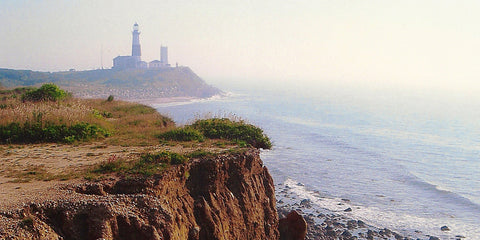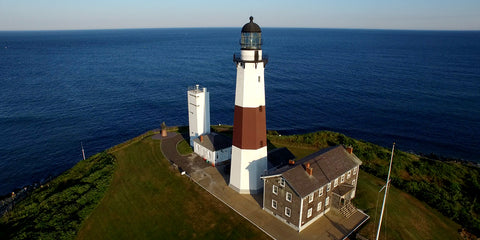A visit to Montauk — Long Island’s easternmost town — will invariably include sightings of signs proclaiming “The End.” The message is simple: this is it for New York. For the most part it’s true, but for a few more miles of road and one major landmark: the
Montauk Point Lighthouse. It is a long-standing navigational tool, a National Historic Landmark, and to many, the symbol of Long Island itself. “The Lighthouse has a galvanizing effect with Long Islanders,” said Henry Osmers, Montauk Lighthouse Historian, “You’re just drawn to it I think.” Mr. Osmers says roughly 85,000 people — a mixture of local residents choosing to stay local for their vacations, as well as visitors from abroad — visited the museum this past year.

The Lighthouse, commissioned in 1792 by President Washington and the second U.S. Congress, sits at the edge of a 68-foot hill overlooking the Atlantic Ocean. The reason it was built? Economics. At the time, the United States’ trade partners Britain and France — countries that played major roles in the Industrial Revolution. “New York was the major part of America’s foreign trade,” said Robert Hefner, a historic preservation consultant who was instrumental in acquiring National Historic Landmark status for the Lighthouse in 2012. “Montauk Lighthouse was built to serve that trade, to encourage ships to come to New York, making it safer.” Mr. Hefner says the campaign to become a landmark took two to three years, and involved sending several dissertations to the National Historic Landmark Program. The Lighthouse’s critical role in making the shipping route to New York City less perilous (and thus its incalculable economic impact) that eventually won over the adjudicating historian at the National Landmark Program. “That was the national significance after looking at many other arguments.” Mr. Osmers says it is the fourth oldest lighthouse in continuous operation in the United States. He added it was also the only lighthouse on Long Island until 1796, when Eaton’s Neck Lighthouse in Northport was built. Incidentally both lighthouses had the same architect — John McComb Jr., who built only one other lighthouse in his career. As for Montauk Point Lighthouse, it originally resided farther away from the shore, but due to erosion it is now near the edge of the hill, an occurrence that was always accounted for. “George Washington knew exactly how many years the Lighthouse would stand until the erosion took over,” said Robin Strong, archivist for the Montauk Library, whose great-great-grandfather Captain James G. Scott served as
lightkeeper from 1885 to 1910. “But they’ve done a lot of work up there.” Among the erosion-control efforts being undertaken at the Lighthouse are a toe wall, which supports the base of the bluff and prevents waves from removing soil; filter box terracing, a restructuring of the slope above the toe wall to provide for vegetation; and a drainage system, which captures the stream of groundwater flowing on top of the bluff, according to the Lighthouse’s website. Mr. Osmers says the importance of preserving the Lighthouse goes beyond the maintenance of a cultural landmark or tourist destination. “It’s still an active aid to navigation,” he said. “You talk to a lot of mariners out here and they still refer to this lighthouse.”
 Aerial view of the top of the Montauk Point Lighthouse. Photo: Christine Murphy.
Aerial view of the top of the Montauk Point Lighthouse. Photo: Christine Murphy.
A turning point for the Lighthouse’s role outside of the nautical community occurred in 1985, when the federal government decided to automate the lighthouse. According to Montauk native Dick White, that also meant shutting down and locking up the adjacent 1860 keeper’s house. “We got ahold of the Coast Guard and said this place is going to be vandalized in no time,” he recalls. “We said we’d like to open up a museum.” Today, the Montauk Historical Society manages the Lighthouse, with Mr. White — who initially visited the property as a first-grader in the 1940s — serving as the chairman of the Lighthouse board. The group is tasked with maintaining the Lighthouse Museum and also keeping an eye on the future. The museum — which resides in the 1860 keeper’s house, includes an assortment of documents and photographs, such as the Lighthouse’s Congressional authorization from President Washington. “We do have on the drawing boards a couple of interesting projects,” Mr. White says. Among these projects is a potential upgrade of the “1838 house,” the former residence of the lightkeeper from 1838 until 1860, currently used as a garage. “Over the years that building has fallen into bad shape,” Mr. Osmers said. “[The board is] weighing the options as to what to do to restore the building.” Both Mr. Osmers and Mr. White said future considerations for the Lighthouse remain in a preliminary stage and they were not ready to discuss them with the public. However, they agree that the Lighthouse as is retains a special place in the eyes of Long Islanders, a sentiment echoed by Gina Piastuck, head of the Long Island Collection at the East Hampton Library. “It’s kind of like an icon, especially for the East End and South Fork,” she said. “I think people would like to have it around for as long as possible.”
For Mr. Osmers, he as an interesting perspective on the matter, as his office is located on the Lighthouse property. He says he sits at his desk and looks out at the Atlantic Ocean. There is no more New York after his building, yet on some days in the summer a thousand people a day flock to his door. “There’s just something about driving to ‘the end’ of Long Island,” he said. Mr. Osmers has another term for it: “The beginning.”

 Aerial view of the top of the Montauk Point Lighthouse. Photo: Christine Murphy.
Aerial view of the top of the Montauk Point Lighthouse. Photo: Christine Murphy.

Leave a comment